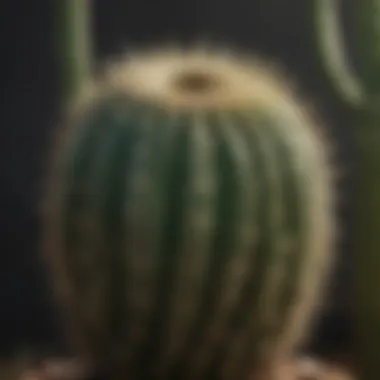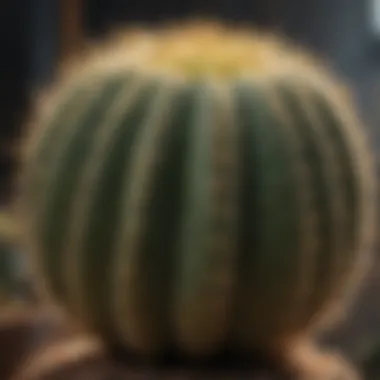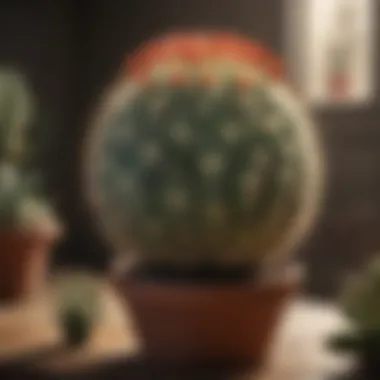Mastering Cactus Trimming: Techniques and Tips


Intro
Trimming cactus plants is vital for their health and growth. While many homeowners relish the unique beauty of cacti, few understand the reasons and methods behind proper trimming techniques. This guide serves to explain the importance of regularly tending to your cacti, the best practices for various species, and the tools necessary for the job. Ultimately, this knowledge empowers enthusiasts to enhance the aesthetic appeal of their space while promoting robust plant health.
Cacti, by nature, require minimal maintenance. However, neglecting to trim these resilient plants can lead to overcrowding, unattractive shapes, or pest infestations. Consequently, each species of cactus demands specific trimming techniques to flourish. Understanding these methods is key to creating healthy, thriving specimens that can improve the overall atmosphere of your living environment.
Equipped with the right tools and techniques, anyone can confidently undertake the task of trimming their cacti. This guide breaks down everything you need to know, ensuring your plants not only survive but thrive.
Understanding Cacti
Understanding cacti is crucial for anyone considering trimming these unique plants. Cacti are not just fascinating due to their resilience but also their specific needs that differ significantly from other types of plants. This section highlights botanical characteristics and different types of cacti, offering essential knowledge for effective upkeep.
Botanical Characteristics
Cacti belong to the family Cactaceae. They are known for their thick stems, which store water, allowing them to thrive in arid environments. One remarkable feature is their spines, which are modified leaves. These spines serve various purposes: they reduce water loss, provide protection from herbivores, and can even help with temperature regulation. Additionally, cacti have a unique photosynthesis pathway called Crassulacean Acid Metabolism (CAM), allowing them to open their stomata at night and reduce water loss during the hot daytime.
In term of growth, cacti can display various patterns. Some species grow tall and columnar, while others spread out or form clusters. These characteristics dictate how they should be trimmed. For instance, understanding the growth pattern helps prevent unnecessary damage during trimming procedures.
Types of Cacti
There are numerous types of cacti, and recognizing the kind you are dealing with aids in proper care and trimming practices. Some common types include:
- Saguaro (Carnegiea gigantea): Famous for its tall, column-like structure, this cactus requires careful trimming due to its size.
- Barrel Cactus (Ferocactus): Shaped like a barrel, these cacti are spiny and often found in deserts. They need minimal trimming but should be checked for health regularly.
- Echinopsis: Known for their beautiful flowers, these round cacti can become leggy. Trimming can promote more compact growth and enhance their aesthetic appeal.
- Christmas Cactus (Schlumbergera): A different type of cactus, often found indoors. This one has more delicate trimming needs because of its seasonal blooms.
Recognizing these types not only helps in knowing their appearance but also in understanding their requirements. Each type has unique traits, directly informing trimming techniques and aftercare.
"Understanding the unique characteristics of your cactus can greatly influence its health and longevity."
Why Trim Cacti?
Trimming cacti is more than just an aesthetic choice; it promotes their health and vitality. In a world where gardening trends evolve, understanding why trimming is essential can set apart the casual hobbyist from the dedicated plant caretaker. The reasons for trimming cacti can be categorized into three main aspects: promoting healthy growth, enhancing aesthetic appeal, and preventing overcrowding.
Promoting Healthy Growth
Trimming cacti encourages robust growth by eliminating damaged or dead parts. When parts of the plant die or become diseased, they can be detrimental to the overall health of the cactus. Removing these sections allows the plant to redirect its energy towards healthier areas, thus promoting new growth. Regular trimming also helps you maintain the right shape of the cactus, which can prevent stress that results from overcrowded branches. This practice essentially aids the plant's natural growth cycle, contributing to a stronger and more resilient cactus.
Enhancing Aesthetic Appeal
Cacti are popular for their unique shapes and textures. However, over time, some specimens may become unbalanced or leggy. Trimming can enhance the visual symmetry and overall appearance of the plant, making it a more attractive addition to any space. Shaping the cactus not only aids its visual presentation but also complements surrounding decor, whether in a home setting or as part of outdoor landscaping. A well-trimmed cactus can draw attention, creating focal points that enhance interior design and landscaping aesthetics.
Preventing Overcrowding
In a habitat where cacti grow, space is crucial. When multiple cacti are clustered too closely, competition for resources such as sunlight and nutrients becomes a problem. This competition may lead to weak and stunted growth. Trimming helps maintain appropriate spacing, allowing each cactus to thrive in its environment. By preventing overcrowding, you enhance the overall vitality of your plants and create a harmonious display that is visually pleasing.
Trimming cacti contributes significantly not only to plant health but also to the overall aesthetics of your gardening efforts.
In summary, the importance of trimming cannot be overstated. The benefits—the promotion of healthy growth, improved aesthetics, and prevention of overcrowding—play a crucial role in cactus care. Understanding and applying these principles is essential for anyone looking to nurture their succulent plants.
Preparing for Trimming
Preparing for trimming cacti is an essential phase that significantly impacts the health and appearance of the plants. Cacti, like other plants, require specific conditions and tools to ensure that trimming is effective and enhances growth. A well-thought-out preparation process minimizes the risk of damaging the cactus and promotes optimal growth post-trimming.


Timing and tools are the two predominant elements in this preparatory stage. A cactus should only be trimmed when it is healthy, actively growing, and free from stressors such as extreme temperatures or lack of water. Additionally, gathering appropriate tools ensures precision and care during the trimming process. The right choices tailor your approach to the species of cactus, leading to a more successful outcome overall.
Choosing the Right Time
The timing of trimming is crucial for the well-being of cacti. Trimming during the wrong season can lead to unwanted damage or stunt the growth of the plant. Spring is generally when most cactus species begin their active growth phase. Trimming at this time allows the cactus to recover quickly. In contrast, trimming during dormancy, usually in winter, can hinder the plant’s health. It is vital to observe the specific species of your cactus, as their growth cycles may vary.
Inspecting the cactus before making any cuts can also be beneficial. If the plant is unhealthy or showing signs of stress, it is advisable to postpone trimming. Adequate hydration and care should be ensured before any changes are made to its structure.
Gathering Necessary Tools
Having the right tools ready is essential in the trimming process. Each tool serves a specific function and contributes to achieving effective and safe trimming.
Gloves
Gloves are not just an optional accessory; they are a necessity for anyone trimming cacti. The primary reason for using gloves is to protect hands from the sharp spines and needles that many cacti possess. A good pair of gloves needs to be thick enough to provide protection but also sensitive enough to allow for careful handling of the plant.
Leather gloves are often considered a beneficial choice due to their durability and strength. They provide adequate resistance against punctures, yet allow for enough dexterity to navigate through the plant while making cuts. A downside may be the need for a break-in period to achieve comfort, but the protection offered makes them worth the consideration.
Pruning Shears
Pruning Shears are an indispensable tool in the cactus trimming toolkit. They enable precise cuts, which are necessary for encouraging healthy regrowth and reducing the risk of damage. When choosing pruning shears, opt for those with sharp, stainless steel blades. The sharpness gives a clean cut, reducing stress on the plant.
By using high-quality shears, you minimize the possibility of jagged edges, which may lead to infections. A disadvantage could be their price and need for regular maintenance, but the investment pays off in both ease of use and the health of the cactus.
Disinfectant
Using disinfectant is crucial for maintaining the health of cacti during the trimming process. Without proper sanitation, tools can transfer bacteria and pathogens to the plant, causing rot or disease.
A common choice for disinfectant is rubbing alcohol. This type of disinfectant is both effective and easy to obtain. The key characteristic of rubbing alcohol is its rapid evaporation, preventing irritation to the plant. However, it must be applied carefully, ensuring not to soak the cactus to prevent any adverse effects.
Properly preparing for trimming by selecting the right time and tools sets a solid foundation for positive results. As you proceed, ensure to prioritize the health and safety of your cactus to achieve the best outcomes.
Trimming Techniques for Different Cacti
Trimming techniques play a vital role in ensuring the health and beauty of cactus plants. Each type of cactus requires a unique approach to maintain its structure and vitality. Knowing the specific trimming techniques facilitates better care and promotes optimal growth. Understanding these differences boosts efficiency and helps avoid damage to the plant. This section explores the techniques needed for columnar, round, and tree-like cacti, providing clear guidance on how to approach each type.
Columnar Cacti
Columnar cacti, such as the popular Saguaro, have a distinctive upright form. These plants grow tall and may branch out as they mature. When trimming, it is crucial to assess the overall form before making any cuts. Focus on removing any dead or damaged arms, as these can detract from the plant's aesthetics. Use sharp pruning shears to make clean cuts, preventing disease entry.
When trimming columnar cacti, consider the following points:
- Timing: Trim during the growing season, typically in spring or early summer. This allows the plant to heal more easily.
- Technique: Remove the arms at their base. Ensure that you do not cut into the main trunk, as this can harm the plant.
- Sanitation: Disinfect tools before and after trimming to prevent pathogen spread.
Round Cacti
Round cacti, including species like Echinocactus and Mammillaria, require a different approach. They tend to grow in a compact shape and can appear dense. The main goal of trimming round cacti is to maintain their form and remove any worn or dead pads. The trim should enhance their natural spherical appearance, not alter it.
Key considerations for round cacti include:
- Timing: Similar to columnar species, spring is also best for trimming round cacti. This period promotes robust growth.
- Technique: Focus on cutting away any dead or shriveled sections. Use sharp shears and make cuts close to the main body, ensuring a clean removal.
- Aftercare: Avoid watering immediately after trimming. Allow cut edges to callus for a few days before reintroducing water.
Tree-like Cacti


Tree-like cacti, such as the Cereus species, exhibit a branching growth pattern resembling a tree. Trimming these requires care to maintain their overall structure. The goal is to encourage lateral growth while ensuring that the plant does not become top-heavy.
For tree-like cacti, keep the following in mind:
- Timing: Again, opt for late spring to early summer for trimming. This coincides with their active growth phase.
- Technique: Remove any excessive growth on top while gently encouraging side growth. Trim lightly rather than excessively to avoid shock.
- Tools: It may be necessary to use saws for larger branches, so ensure that the tools are appropriately cleaned.
It is essential to respect the species-specific growth patterns when trimming cacti. Understanding what each type requires leads to healthier plants.
Step-by-Step Trimming Process
The step-by-step trimming process is essential for maintaining the health and appearance of your cactus plants. Understanding this process allows gardeners to make informed decisions while trimming, ensuring they do not harm the plant. This careful approach not only encourages healthy growth but also enhances the overall aesthetic of the cactus. Following systematic steps ensures consistency and effectiveness.
Assessing the Plant
Before you begin trimming, it is vital to assess the cactus thoroughly. Look for areas that require trimming, such as dead or damaged segments. Assessing involves observing the plant from multiple angles and identifying where the growth appears too dense or uneven. It is important to check for any signs of pests or disease, as trimming a stressed cactus can cause further harm. Taking notes on which areas need attention helps in planning the trimming process. To record your observations, consider using a journal.
Making the Cut
Once you have assessed the plant, it is time to make the cut. Use sharp pruning shears to ensure clean cuts, which minimizes the risk of infection to the plant. Hold the shears at a 45-degree angle to promote healing. Start by cutting away the most obvious dead parts first. Then, trim away any unwanted growth, keeping in mind the shape of the cactus. Aim to balance the shape while ensuring the plant can still photosynthesize effectively. Each cut should be precise to avoid unnecessary stress.
Disposing of Trimmings
After trimming, proper disposal of the trimmings is crucial. Cactus material can harbor pests or diseases, so do not leave them nearby. Collect the trimmings and place them in a sealed bag for disposal. If the cut sections are healthy, consider propagating them. Ensure that any trimming tools used are cleaned with disinfectant. This practice further reduces the risk of transmitting diseases to your other plants. Proper disposal reinforces overall garden hygiene and plant care.
Post-Trimming Care
After trimming a cactus, providing proper care is essential for its recovery and continued growth. This phase is crucial because it helps to ensure that the plant adapts well to its new form and maintains its health. It can also prevent stress that may occur from trimming, which can lead to more significant issues if not addressed. The post-trimming care process involves a few key elements: watering, fertilization, and monitoring for pests.
Watering Guidelines
Watering is a vital aspect of post-trimming care for cacti. After trimming, the immediate impulse may be to water the plant generously, but caution is necessary. Cacti are adapted to survive in arid conditions, and overwatering can lead to root rot.
- Timing: Wait at least one week after trimming before watering. This allows the cut areas to heal.
- Technique: When watering, ensure that the soil is dry to the touch before applying water again. Check the soil moisture with your finger.
- Amount: Apply water directly at the base of the cactus. It is important to moisten the soil without creating standing water around the roots.
- Container Consideration: If the cactus is in a pot, ensure that it has good drainage to prevent excessive moisture.
Fertilization
Fertilization after trimming is a common question among cactus owners. During this recovery phase, cacti do not need heavy feeding. An appropriate approach includes:
- Timing: Wait approximately one month after trimming to allow the plant to stabilize.
- Type of Fertilizer: Use a diluted, balanced fertilizer designed specifically for succulents and cacti. Avoid high-nitrogen fertilizers, as they may encourage unwanted soft growth that could weaken the plant.
- Frequency: Fertilize only once during the growing season. Over-fertilizing can stress the plant.
Monitoring for Pests
Post-trimming, cacti may become vulnerable to pests due to the stress of the trimming process and their open wounds. It is vital to keep an eye on your plants for signs of infestation.
- Common Pests: Look for mealybugs, spider mites, and scale insects.
- Inspection: Check both the top and underside of the cactus. Look for any unusual discoloration or webbing.
- Action: If pests are found, treat them promptly. A mixture of water and mild soap can be effective for removing pests without harsh chemicals. Regular monitoring can prevent significant damage.
Proper post-trimming care ensures that your cactus heals well and continues to thrive, reducing the risk of issues like pest infestations and poor growth conditions.
Common Mistakes to Avoid
When it comes to trimming cacti, many enthusiasts may overlook essential aspects that lead to undesirable outcomes. Understanding these common mistakes helps ensure the longevity and health of your plants. Trimming is not simply about aesthetics; it’s a crucial process that affects overall growth, appearance, and vitality. Avoiding these mistakes allows gardeners to build a more resilient and attractive cactus collection.


Over-Trimming
Over-trimming is perhaps the most prevalent issue among novice cactus caretakers. It might seem intuitive to aggressively cut back on growth for a neater appearance, but this often leads to detrimental results. Cacti have adapted to thrive in harsh environments and, therefore, have developed specific growth patterns.
Excessive cutting can cause stress to the plant, leading to reduced vigor and potentially hindering its natural ability to photosynthesize. A cactus usually requires a certain amount of foliage and green segments to sustain healthy growth. When trimming, one should aim to remove only the necessary parts—typically dead or unhealthy segments—to promote new growth without putting undue stress on the plant. Keeping an eye on the general shape of your cactus is often a good practice.
Ignoring Species-Specific Needs
Each cactus species exhibits distinct characteristics that dictate its care and trimming requirements. Ignoring these specific needs can lead to ineffective trimming and even harm the plant. For example, the way you approach a Saguaro cactus should differ significantly from a barrel cactus.
Some species may not require frequent trimming, while others may need regular maintenance to manage growth effectively. Researching your particular species and understanding its growth habits is crucial. Some cacti flourish with minimal intervention, whereas others respond well to strategic trimming. Knowledge about various cactus types ensures that trimming practices cater to their unique needs, enhancing health and aesthetics.
Neglecting Sanitation Practices
Sanitation may not always come to mind when thinking about trimming, but it plays a vital role in the overall health of your cacti. Failing to clean tools before and after use can introduce pathogens that might infect your plants. Contaminated pruning shears can spread diseases from one plant to another.
To avoid this, it is important to use disinfectants on tools before beginning the trimming process. These practices not only ensure a cleaner environment for your cacti but also promote a healthier growing process. Keeping sanitation at the forefront contributes to the establishment of a thriving cactus garden.
"Proper attention to detail during the trimming process reflects one's dedication to maintaining a healthy cactus environment."
In summary, being mindful of over-trimming, respecting species-specific characteristics, and adhering to sanitation practices can dramatically improve the success of your cactus trimming endeavors. By avoiding these mistakes, you cultivate not only healthier plants but also enrich your gardening experience.
The Role of Cacti in Sustainable Gardening
Cacti are often viewed purely for their uniqueness and visual appeal. However, they have a significant role to play in sustainable gardening practices. Cacti can thrive in arid conditions and often require less care than traditional garden plants. This makes them ideal for gardeners looking for eco-friendly options. By understanding their place in sustainable gardening, you can better appreciate the benefits they provide to both your space and the environment.
Water Conservation
One of the primary advantages of incorporating cacti into your garden is their ability to conserve water. Cacti are adapted to arid environments thanks to their thick stems that store moisture. This unique trait allows them to survive long periods without rain.
When you choose to cultivate cacti, you reduce the overall water usage of your garden. The demand for intensive irrigation typically associated with conventional gardening can be significantly lowered. By selecting cacti, especially in dry regions, you support both a sustainable lifestyle and the well-being of your local ecosystem.
Furthermore, embracing cacti helps to combat water wastage. Over time, this practice can lead to water savings that have a positive ripple effect on your community.
Biodiversity Benefits
Cacti contribute to biodiversity in several ways. They provide essential habitats for various wildlife species. Birds, insects, and small mammals often rely on cacti for food and shelter. The diversity of plant life contributes to healthier ecosystems and promotes a balanced environment.
Cultivating cacti in your garden also supports pollinators like bees and butterflies. Many cacti feature impressive flowers that attract these creatures, fostering essential pollination processes. Such interactions are vital for maintaining the broader health of various plant species.
In addition, growing diverse plant life, including cacti, creates a more resilient garden. It enhances the garden's ability to withstand pests and diseases, reducing the need for chemical treatments.
"Incorporating cacti into your gardening practice is not only about aesthetics; it promotes water conservation, supports biodiversity, and contributes to environmental health."
In summary, the role of cacti in sustainable gardening cannot be overlooked. With their capacity for water conservation and support of biodiversity, they stand as a viable option for eco-conscious gardeners. As you trim and care for your cacti, you actively engage in practices that benefit both your garden and the planet.
Ending
In closing, this article underlines the critical importance of maintaining cacti through effective trimming practices. Trimming is not merely an aesthetic choice; it profoundly influences the health and vitality of these unique plants. Regularly trimming cacti promotes lush growth, helps manage their size, and encourages budding cycles. Homeowners and gardening enthusiasts alike benefit from understanding the nuances of this technique.
Recap of Key Points
To summarize, the following points stand out:
- Promoting Healthy Growth: Trimming aids in directing the plant's energy towards new growth rather than maintaining dead or unproductive segments.
- Enhancing Aesthetic Appeal: Thoughtful trimming can transform the visual impact of a cactus, making it a focal point in home decor.
- Choosing the Right Tools and Timing: Quality tools and appropriate timing are essential for a satisfactory trimming process. The right approach minimizes risk and results in cleaner cuts.
- Post-Trimming Care: Adhering to guidelines for watering and monitoring pests is crucial for the health of your trimmed cacti.
Encouragement for Cactus Enthusiasts
For those passionate about cacti, dive deeper into the practices outlined here. Every cactus tells a story, and through attentive care and trimming, you can enhance its narrative. Cactus cultivation is a rewarding hobby that merges art with science. Each decision you make regarding the care of your plants contributes to a sustainable approach to gardening. Remember, a well-trimmed cactus can be a beautiful centerpiece that reflects not only personal style but also ecological consciousness. Embrace your role as a steward of these fascinating plants and continue to learn and adapt your care techniques.















